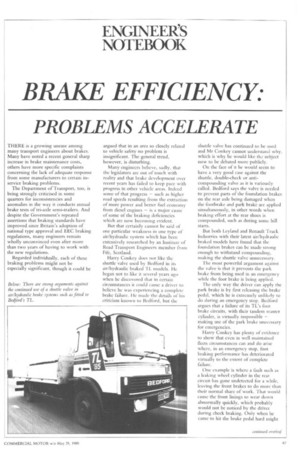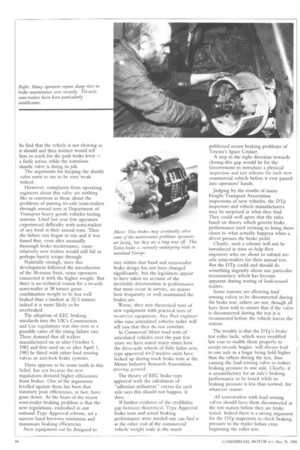BRAKE EFFICIENCY:
Page 69

Page 70

If you've noticed an error in this article please click here to report it so we can fix it.
PROBLEMS ACCEI,ERATE
THERE is a growing unease among many transport engineers about brakes. Many have noted a recent general sharp increase in brake maintenance costs, others have more specific complaints concerning the lack of adequate response from some manufacturers to certain inservice braking problems.
The Department of Transport, too, is being strongly criticised in some quarters for inconsistencies and anomalies in the way it conducts annual brake tests of tri-axle semi-trailers. And despite the Government's repeated assertions that braking standards have improved since Britain's adoption of national type approval and EEC braking regulations, many engineers remain wholly unconvinced even after more than two years of having to work with the new regulations.
Regarded individually, each of these braking problems might not be especially significant, though it could be argued that in an area so closely related to vehicle safety no problem is insignificant. The general trend, however, is disturbing.
Many engineers believe, sadly, that the legislators are out of touch with reality and that brake development over recent years has failed to keep pace with progress in other vehicle areas. Indeed some of that progress — such as higher road speeds resulting from the extraction of more power and better fuel economy from diesel engines — is a major cause of some of the braking deficiencies which are now becoming evident.
But that certainly cannot be said of one particular weakness in one type of air/hydraulic system which has been extensively researched by an Institute of Road Transport Engineers member from Fife, Scotland.
Harry Conkey does not like the shuttle valve used by Bedford in its air/hydraulic braked TL models. He began not to like it several years ago when he discovered that in certain circumstances it could cause a driver to believe he was experiencing a complete brake failure. He made the details of his criticism known to Bedford, but the shuttle valve has continued to be used and Mr Conkey cannot understand why, which is why lie would like the. subject now to be debated more publicly.
On the face of it he would seem to have a very good case against the shuttle, double-check or anticompounding valve as it is variously called. Bedford says the valve is needed to prevent parts of the foundation brakes on the rear axle being damaged when the footbrake and park brake are applied simultaneously, in other words when braking effort at the rear shoes is compounded, such as during seine hill starts.
But both Leyland and Renault Truck Industries with their latest air/hydraulic braked models have found that the foundation brakes can be made strong enough to withstand compounding, making the shuttle valve unnecessary.
The most powerful argument against the valve is that it prevents the park brake from being used in an emergency while the foot brake is being applied.
The only way the driver can apply the park brake is by first releasing the brake pedal, which he is extremely unlikely to do during an emergency stop. Bedford argues that a failure of its TL's foot brake circuits, with their tandem master cylinder, is virtually impossible — making use of the park brake unecessary for emergencies.
Harry Conkey has plenty of evidence to show that even in well maintained fleets circumstances can and do arise where, in an emergency stop, foot braking performance has deteriorated virtually to the extent of complete failure.
One example is where a fault such as a leaking wheel cylinder in the rear circuit has gone undetected for a while, leaving the front brakes to do more than their normal share of work. That would cause the front linings to wear down abnormally quickly, which probably would not be noticed by the driver during check braking. Only when he came to hit the brake pedal hard might he find that the vehicle is not slowing as it should and then instinct would tell him to reach for the park brake lever — a futile action while the notorious shuttle valve is doing its job.
The arguments for keeping the shuttle valve seem to me to be very weak indeed.
However, complaints from operating engineers about this valve are nothing like as common as those about the problems of putting tri-axle semi-trailers through annual tests at Department of Transport heavy goods vehicles testing stations. Until last year few operators experienced difficulty with semi-trailers of any kind at their annual tests. Then the failure rate began to rise and it was found that, even after unusually thorough brake maintenance, some relatively new trailers would still fail or perhaps barely scrape through.
Naturally enough, since this development followed the introduction of the 38-tonne limit, some operators connected it with the higher weight. But there is no technical reason for a tri-axle semi-trailer at 38 tonnes gross combination weight to be less well braked than a tandem at 32.5 tonnes; indeed it is more likely to be overbraked.
The adoption of EEC braking standards into the UK's Construction and Use regulations was also seen as a possible cause of the rising failure rate. These demand that all trailers manufactured on or after October 1, 1982 and first used on or after April 1, 1983 be fitted with either load sensing valves or anti-lock brake systems.
There appears to be some truth in this belief, but not because the new regulations demand higher efficiencies from brakes. One of the arguments levelled against them has been that statutory peak efficiencies, in fact, have gone down. At the heart of the recent semi-trailer braking problem is that the new regulations, embodied in our national Type Approval scheme, set a narrow band between minimum and maximum braking efficiencies.
New equipment can be designed to stay within that band and semi-trailer brake design has not been changed significantly, but the legislators appear to have taken no account of the inevitable deterioration in performance that must occur in service, no matter how frequently or well maintained the brakes are.
Worse, they mix theoretical tests of new equipment with practical tests of in-service equipment. Any fleet engineer who runs articulated vehicles today will tell you that they do not correlate.
In Commercial Motor road tests of articulated vehicles over the past few years we have noted many times how the drive-axle wheels of fully laden new, type approved 4x2 tractive units have locked up during track brake tests at the Motor Industry Research Association. proving ground.
The theory of EEC brake type approval with the calculation of "adhesion utilisation" curves for each axle says this should not happen. It does.
If further evidence of the credibility gap between theoretical, Type Approval brake tests and actual braking performance were needed one can find it at the other end of the commercial vehicle weight scale in the much publicised recent braking problems of Toyota's Space Cruiser.
A step in the right direction towards closing this gap would be for the Government to introduce a physical inspection and test scheme for each new commercial vehicle before it ever passed into operators' hands.
Judging by the results of many Freight Transport Association inspections of new vehicles, the DTp inspectors and vehicle manufacturers may be surprised at what they find. They could well agree that the rules based on theory which govern brake performance need revising to bring them closer to what actually happens when a driver presses the brake pedal.
Clearly, such a scheme will not be introduced in time to help fleet engineers who are about to submit triaxle semi-trailers for their annual test. But the DTp could and should do something urgently about one particular inconsistency which has become apparent during testing of load-sensed trailers.
Some stations are allowing load sensing valves to be disconnected during the brake test, others are not, though all have been told to ensure that if the valve is disconnected during the test it is reconnected before the vehicle leaves the station.
The trouble is that the DTp's brake test roller beds, which were modified last year to enable them properly to accept tri-axle bogies, will always lead to one axle in a bogie being held higher than the others during the test, thus causing the load sensing valve to reduce braking pressure to one axle. Clearly, it is unsatisfactory for an axle's braking performance to be tested while its braking pressure is less than normal, for whatever reason.
All semi-trailers with load sensing valves should have them disconnected at the test station before they are brake tested. Indeed there is a strong argument for the DTp inspectors to check braking pressure to the trailer before even beginning the roller test.












































































































